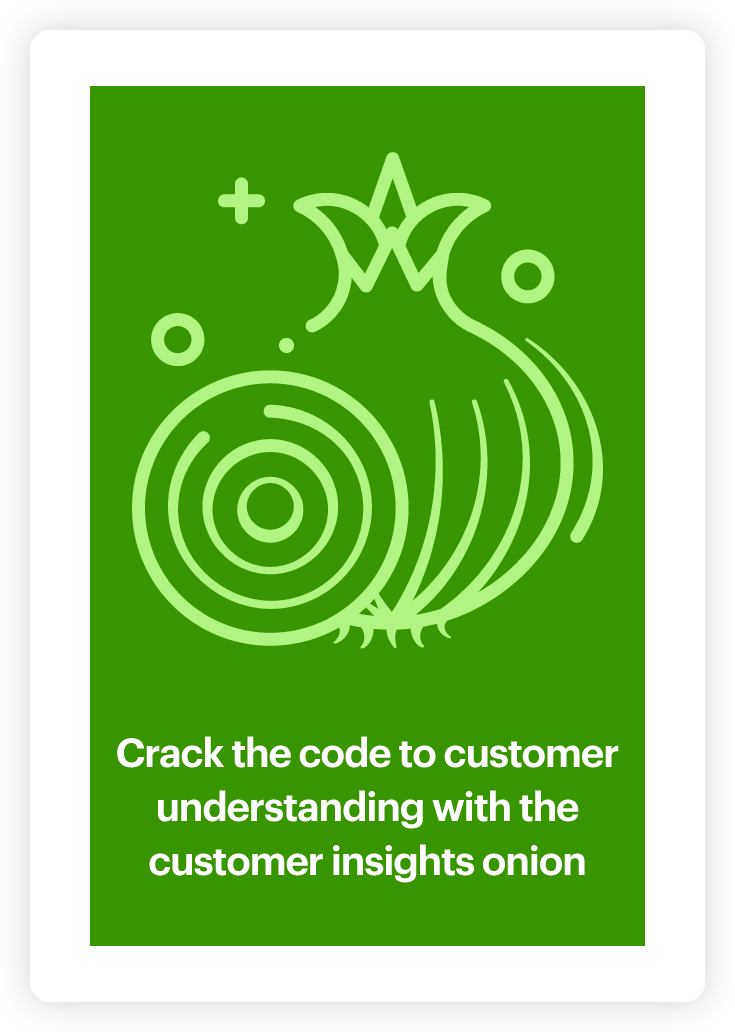5 brand perception customer insights examples

No brand can be truly successful without understanding what matters to its customers. What do customers think about your brand vs. your competitors? How does brand perception vary across different audiences or customer segments? Does the way you see yourself align with the way customers perceive you? Brand perception customer insights provide the answers to all of these questions and more.
The most common sources of data used to generate brand perception customer insights are customer feedback surveys, social media conversations and online reviews. Especially when analyzed with the help of a powerful customer insights platform, these types of customer data can provide brands with an in-depth understanding of consumer behavior and sentiment.
The importance of this type of insight is illustrated by the fact that 90% of fortune 500 companies already use competitive intelligence to gain an advantage over their industry competitors.
In this article, we explore five brand perception customer insights examples across three categories: brand vs. brand comparison, over time trend analysis and customer segment comparison.
Brand vs. brand comparison
One surefire way brands assess brand perception is by conducting competitor brand analysis. This type of analysis typically leverages online reviews or social conversations to reveal points of differentiation, unique challenges and potential opportunities for brands. Equipped with these competitive insights, brands can promote what makes them unique, improve areas where the competition outperforms and drive innovation that addresses unmet market needs.
1) Competitor analysis using online reviews
Online reviews are among the most popular data sources used for competitor research analysis. Using our customer insights platform, we set out to compare G2 reviews of the three largest marketing automation tools (HubSpot, Eloqua and Marketo) in order to understand what marketers think about each platform.
Eloqua was able to impress with its multi-step campaign-building and information-sharing functions while disappointing users in terms of the overall interface and customer experience. HubSpot, on the other hand, won over users with its user-friendliness and excellent customer service. The main critiques from HubSpot customers were centered around the platform’s limited functionality and pricing. Last but not least, when using Marketo, power and impressive functionality come at a cost: long waiting times.
Equipped with these insights, HubSpot may deploy a marketing campaign focused on ease of use and their excellent support while Marketo and Eloqua might choose to focus on improving platform speed and the user interface.
2) Reveal competitive advantages
Over the past decade, mental health and well-being have gradually become a prominent focus in our everyday lives. As a result, the popularity of mindfulness apps has sky-rocketed. We used our customer insights platform to analyze customer reviews for two of the most popular mindfulness apps Calm and Headspace to see what sways audiences towards downloading one app over the other.
Our analysis found that in terms of user-friendliness and animations, Headspace is definitely hitting the nail on the head. Headspace also manages to utilize gamification to encourage user engagement, by motivating them with meditation ‘streaks’ on the app. This functionality, however, evokes mixed feelings in users, who either love the challenge or get discouraged and demotivated when the app resets their streaks.
When it comes to meditation, soothing voices are of utmost importance to users – in the case of Headspace, customers love Andy’s relaxing and calming voice. For Calm, Tamara’s voice, which users call irritating, has quite the opposite effect. While the Calm app doesn’t impress with its narrators, its special Calm Kids section and influencer partnerships highly resonate with customers.
Seeing how well Calm used influencer partnerships to boost its brand perception, app reviews and downloads, Headspace might want to create similar brand partnerships. Calm, on the other hand, could focus on the popularity of its Calm Kids feature throughout its marketing communications.
Over time trend analysis
Typically generated by comparing customer feedback responses, reviews or social conversations from one time period against another, over-time comparisons help brands monitor how customer feedback, sentiment, attitudes and brand perception change over time. This knowledge enables brands to spot trends, explain changes in customer attitudes and measure the impact of marketing efforts and product updates.
3) Monitor brand perception over time
Brand perception can drastically change over time, especially for sectors like the automotive industry that are constantly subjected to innovations and introductions of new technologies, such as electric vehicles or autonomous driving. To illustrate this type of shift in brand perception, we used Relative Insight to analyze customer feedback about Vauxhall and Hyundai between 2016 and 2021.
Our customer insights analysis revealed that between 2016 and 2018, Vauxhall customers were more likely to have a negative attitude towards the brand, both concerning the product, as well as the customer service. This negative perception of quality drastically shifted in recent years. Feedback from 2019 to 2021 highlighted that consumers loved the product but still complained about unpleasant customer service experiences. Hyundai customer reviews from 2016 to 2018 were likely to mention battery issues and disrespectful encounters at car dealerships. These pain points were replaced with an increased concern for cost in the latter time period, suggesting that value and car maintenance costs have become a key factor for Hyundai customers.
Considering that communicating with customers at a dealership is key to encouraging sales and boosting customer satisfaction, Hyundai could consider improving training to ensure consistency in employee behavior. Similarly, Vauxhall could choose to focus on improving customer service to ensure that people are just as happy with the overall brand as they are with their cars.
4) Track consumer behavior and sentiment during times of crisis
Appealing to customers in times of crisis such as pandemics, recessions or inflation can be challenging given the impact of such events on purchasing behaviors and preferences. This is why it’s imperative to keep a pulse on how brands or industries are perceived by consumers, while simultaneously pinpointing changes in overall customer sentiment.
One of the first things consumers tend to cut down on to save money in a recession economy is the number of streaming services they subscribe to. To gauge how the 2022 cost of living crisis impacted streaming service subscriptions, we analyzed negative reviews of leading streamers including Disney+, Netflix and Prime Video.
Our analysis revealed that every streaming app is criticized for specific technical issues: Disney+ is often slow, Now TV is prone to crashing, Apple TV’s audio doesn’t always work and Prime Video users get frustrated about the app’s language settings. Netflix is the only streaming app that isn’t criticized for a particular technical issue. Users tend to criticize the app more generally for aspects such as price increases or the limited screen factor. Disney+, on the other hand, is the only app where customers don’t explicitly question price and value. Generally, customers have very strong feelings about each app – that is except for Apple TV. Apple TV subscribers seem to have more of a transactional relationship with the app and express little emotion in their complaints.
Given that there’s no clear winner among the different platforms, all brands should consider fixing their technical issues and persuading users through the quality of their content offerings in their marketing communications.
Comparing customer segments
Brand perception is complex – something that resonates with one of your target audiences might not appeal to another. To gain a deeper understanding of each customer group, brands can leverage customer surveys, reviews, online forums or social media conversations to compare different demographic customer segments. Understanding what matters to different genders, generational groups or geographic markets and pinpointing respective similarities and differences helps brands personalize marketing, communications and customer service strategies – a great way businesses can ensure that their brand resonates with every consumer group.
5) Understand differences between different customer segments
To illustrate how widely brand perception can vary from one geographic location to another, we analyzed online forum conversations around US sports like the NFL, NBA and MLB against conversations regarding UK sports such as rugby, cricket and soccer. With online sports betting legally expanding across the US, we wanted to understand how gamblers in an established industry like the UK talk compared to those in the emerging American market.
Our audience analysis found that Americans and Brits use starkly different lingo when it comes to sports betting. Americans approached betting from a statistical or systematic point of view, referencing specific percentages and numbers, while also being more likely to have emotive responses to game results – they even go as far as calling games that didn’t end in their favor fraudulent or manipulated. Brits, on the other hand, relied on luck rather than statistics for their bets. They generally used positive language when discussing sports betting online, implying that gambling is an enjoyable pastime for UK audiences.
Equipped with these insights, brands know that in order to appeal to UK betters, they need to use language around ‘luck’ while attracting US audiences with stats.
Outmanoeuvering the competition with brand comparison insights
These five examples of brand comparison customer insights showcase a few of the endless ways consumer insights can be applied to improve brand perception, retain customers during times of crisis, conquer market gaps or have an edge over the competition. One thing, however, is clear: in today’s competitive landscape, customer insights must lie at the heart of any business’s successful data-driven decision-making.
Can’t get enough of intriguing competitive brand customer insights like these? Explore more customer insights examples for businesses or book a no-commitment discovery call with one of our experts.
